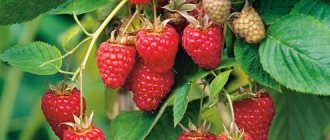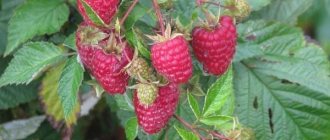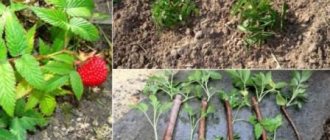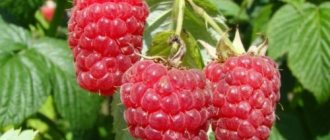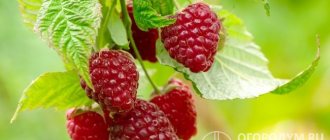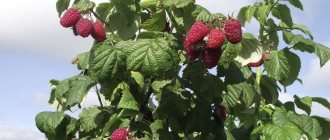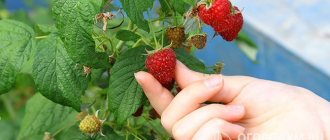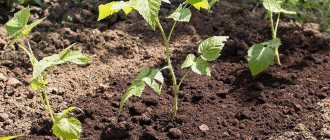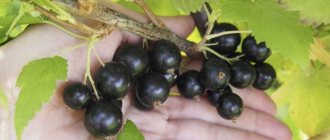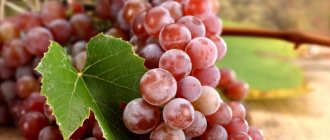The variety is often called Izobilnaya Kazakova raspberry, since raspberries were bred by breeders Kazakov and Kichina by crossing a representative of the Stolichnaya variety with one of the British varieties - No. 39116/94. The variety is intended for temperate continental climates.
AGRO PREMIUM is an innovative, environmentally friendly plant activator, without chemicals, that protects berries, fruits and vegetables from pests and diseases, increases seed germination, stimulates root formation and plant growth, and significantly increases productivity.
The name Izobilnaya raspberry variety implies a fairly high yield, large fruit size, sweetness of the berries and ease of care. The stability of a high yield is guaranteed under very hot conditions in summer and fairly cold weather in winter.
Description of the variety
Izobilnaya raspberry belongs to the remontant varieties and allows you to obtain harvests from both one-year and two-year-old shoots.
Bush
The bushes are semi-spreading, compact, height 2.5-3 m, thornless. Can form 10 shoots and 5 root shoots. The trunk is elastic, thick and light brown in color. The foliage has a rich dark green color.
Annual bushes are elastic, strong, covered with a felt coating, partially waxy in the lower part, internodes are shortened.
The strength of the shoots has its downside: they do not bend very well, and they may break when covered for the winter or when removed from the trellis.
Two-year-old raspberry seedlings Izobilnaya reach 3-3.5 cm in diameter, strong and powerful. There are at least 20-25 and up to 35-40 berries on the fruit branches.
Fruit
The berries are large, up to 12 grams, have a glossy surface and bright red color. One bush gives up to 8 kg of a full harvest.
The fruit has a dense structure and tolerates transportation well and does not lose its quality during storage in refrigerated chambers. Raspberries are used for consumption, both fresh and for preservation.
General characteristics
The variety is frost-resistant, withstands periodic frosts of -30 degrees. Ripening begins at the beginning of July and ends by the end of the month.
If the temperature is too low, there are cases of freezing of shoots up to 50 cm from the ground and freezing of the root system. Without shelter, a mild snowy winter with t -25C is not scary.
The high temperatures of the south are no less negative: the berries bake, and without shading and drip watering, adult plants and young raspberry seedlings may fall out.
More on the topic: The best raspberry varieties for growing in the middle zone
Reviews from gardeners
Maria, Volgograd: “In my opinion, the main advantage of this variety is the sufficient density of the berries. The harvest is good, it doesn’t require special care, the main thing is to water it on time.”
Ivan, Moscow region: “The yield of my Abundant is simply crazy. The berries are large and very tasty. True, the Beauty of Russia still surpasses it. It reproduces very quickly by shoots. I grow them on trellises. But for the winter, the shoots need to be untied, laid on the ground and covered.”
Maxim, Krasnodar: “Izobilnaya couldn’t stand the heat of this summer. Despite watering, everything fell down. I decided to uproot all the bushes and plant a different variety. Although before this this variety showed good yield.”
5 / 5 ( 1 voice )
Advantages of the variety
- High, regular yield;
- Good taste and commercial characteristics of berries;
- Raspberry resistance to most types of diseases and pests;
- High frost resistance;
- Lack of thorns on the shoots;
- Self-fertility.
Flaws
- Tall shoots must be tied up;
- The strength of the shoots makes it difficult to bend them down for shelter;
- The need to cover bushes in regions with little snow in winters;
- The berries are baked in the sun;
- The dependence of the taste and quality of the crop on climate and soil.
Advantages and disadvantages
Most gardeners prefer to grow Patricia raspberries. The positive characteristics of the variety have made Patricia raspberries popular in Russia and Europe. The main goal of every gardener is to get a big harvest.
Advantages of the variety:
- With proper care, the plant develops intensively;
- High annual yield within three years after planting the bushes (one bush yields from 4 to 8 kg);
- Large purple berries, cone-shaped;
- Easy shoot care;
- The frost-resistant variety allows it to be grown in many regions of Russia. Raspberry Tarusa Patricia can withstand frosts up to 30 degrees;
- Tasty and aromatic berries, with a minimal content of seeds in the pulp;
- The bushes do not need to be planted in the shade. In open areas, the foliage does not burn or turn yellow. The amount of light does not affect ripening and yield;
- Ripe berries do not fall off for a long time, do not disintegrate during harvesting, and retain their original appearance;
- Long fruiting period: fresh berries can be picked from early June to August;
- The variety is resistant to many diseases.
Among the disadvantages are:
- Large raspberries have poor transportability; the berries are difficult to release into mass production;
- In case of a rainy summer or excessive watering, there is a high chance that the crop will begin to rot;
- It is recommended to periodically inspect the bushes for diseases. Infected branches can harm an entire bush. The fungus quickly spreads to healthy leaves;
- Due to the active growth of branches, bushes should be trimmed regularly and the holes around them should be taken care of;
- When using strong fertilizers, the taste of the berries changes, and nitrates enter the raspberry pulp.
When describing the Patricia raspberry variety, it is worth noting that there are few shortcomings. Growing a plant does not require a lot of time and effort from gardeners
It is important to follow simple recommendations when planting a plant, properly care for the bushes and reap enviable harvests every year
For sale, such raspberries are collected together with the stalks, so the berries retain their properties longer and do not spoil. Large berries and the absence of thorns on the stem make harvesting a quick and enjoyable experience for gardeners.
Most reviews from gardeners about the Patricia raspberry variety are positive. Many people note the sweet taste of the berries; raspberries are aromatic and large. The plant is not picky about weather conditions and tolerates both heat and frost. If the summer is not sunny, the harvest remains large. There are some peculiarities in planting and caring for the plant. If you take the tips into account, the Patricia variety will become your favorite.
Landing
No matter how undemanding the raspberry variety is, certain conditions are necessary for its favorable growth and obtaining a good harvest. One of them is proper landing.
Soil preparation
Infertile soil in a raspberry patch will not be able to provide the shrub with sufficient opportunities for normal growth and fruiting. Deep digging of the soil and application of fertilizers is necessary. It should be organic and mineral complex.
The right choice of seedlings of the Izobilnaya variety
For planting, it is best to purchase annual plants. There should be 2-4 shoots on the roots. The height of the bush should not be more than a meter. The root should be branched, and the trunk should not be damaged, without any foreign spots.
Selecting a site for planting
The area prepared for planting Izobilnaya seedlings must have a distance of more than 1.5 m to groundwater. If planting is done in the spring, then the land is prepared in the fall.
Raspberries do not like acidic soils; for this it is necessary to reduce the acidity level. This can be done by using lime or wood ash.
Raspberries of the Izobilnaya variety do not like piercing winds, so they need to be planted in a quiet place. This is a light-loving plant, but to avoid burns, the location should not be chosen in direct sunlight.
Disembarkation scheme
Planting can be done both in holes and in trenches. After the autumn preparation of the site, the specific holes or trenches for planting the crop are prepared. The earth taken out of the hole (trench) is mixed with organic matter and the addition of nitroammophosphate and wood ash.
A quarter of the mixed soil is poured into the bottom of the dug holes. The bush descends, but before that its roots are sprayed with the growth stimulator Kornevin and dipped in mash. The root is covered with earth, the hole is compacted, but not very much.
Then the planting is watered, one bucket of water per bush. The soil around the planting is mulched. For this, sawdust, rotted straw, and pine needles are used.
More on the topic: Wild raspberries: revealing secrets
The dimensions of the holes and trenches are within 40/40/50 cm.
Growing and care
Garter
The main shoots of the Izobilnaya raspberry grow up to 2 - 2.5 m, but under certain conditions they can grow up to 3.5 m. This creates difficulties when caring for the bush, picking berries, and shades the bush. The shoots bend under the weight of the berries, the wind breaks the fruit branches, and clutters the aisles. Therefore, the bushes need a garter. To do this, install trellises with wire stretched in 2-3 rows, onto which both last year’s and young shoots are fixed.
Watering
In the southern regions, it is impossible to get a good harvest of high-quality raspberries from Izobilnaya without drip or trench irrigation. Raspberries are an extremely moisture-loving plant, especially if the variety has a large bush mass and high yield. In the northern regions, the main watering is carried out in the summer. The main rules for watering raspberries: the soil should always be moistened to a depth of 30-40 cm, and before harvesting, watering should be less intense to ensure dry harvesting and good transportability of the berries.
Trimming
In spring and autumn, dry, diseased, damaged, and also fruit-bearing branches are cut out from the raspberry field. In the spring, the tips of the shoots of Izobilnaya are pinched to stimulate the growth of lateral branches on which fruit clusters are formed. In summer, when raspberries grow above 2 meters, the shoots are cut to the height of the trellis.
Feeding
Raspberry Izobilnaya must be fertilized at least 3 times per season. However, if before planting the site was properly prepared and fertilizers were applied, then the following fertilizing is applied for 3-4 years. In the fall, you can scatter fresh manure along the rows; if there is none, you can add saltpeter and urea in the spring. Nitrogen fertilizers are needed to maintain the vegetative growth of bushes. Before flowering and before the berries begin to fill, mineral fertilizers are applied; they are necessary for good fruit set, the quality and taste of the future harvest. Abundant responds well to the application of ash, a complex of mineral fertilizers, and compost. After picking the berries, it is also necessary to support the raspberries with organic fertilizers in the form of bird droppings and herbal infusions.
Reproduction
Raspberry Izobilnaya produces quite a lot of root shoots per season, which are usually enough to enlarge the raspberry tree several times.
Preparing for winter
To preserve raspberry trees at 30 degrees below zero, the snow cover height must be at least 1-1.5 meters, and if the winters have little snow, then unbent shoots often freeze out. In this case, not only thin and weak, but also last year’s strong branches die. Therefore, in such climatic conditions, the bushes need to be untied from the supports and bent in the fall while they are flexible. If possible, cover with geotextiles, spruce branches or any other covering material.
Caring for Izobilnaya raspberries
Watering
Raspberries of the Abundant variety are moisture-loving, but the norm must be observed. This crop favors sprinkling irrigation. It also needs watering during the period of fruit development and ripening.
Up to three buckets of water per bush is enough. It is best to water before or after the heat subsides. During dry periods, it is better to increase the frequency of watering.
Loosening the soil and weeding
Loosening and mulching the soil is best done after each watering.
Weeding is carried out after they appear, and also in conjunction with loosening.
Top dressing
Abundant is demanding of fertilizers. The first feeding is done in the spring in April, diluting 1 kg of organic matter per bucket of water. The trunk part of the plant is watered.
The second feeding is carried out in June, applying a layer of up to 5 cm under the mullein bush. The third feeding is wood ash, ammonium nitrate, peat or compost.
Main characteristics
The flowers are small in size, collected in racemose inflorescences, each of which can form a large number of ovaries.
At least 30 berries can ripen on each fruit branch. The fruits are very large, their shape is conical, elongated, with blunt tips. The weight of ripe berries can reach 13-15 g; with proper care, their weight can be up to 18 g. The color of ripe shiny fruits is a rich ruby color.
Photos of growing Izobilnaya raspberries
The drupes are tightly fastened together, so the berries do not crumble during the ripening process, and they tolerate transportation well at any distance without releasing juice.
The pulp of the fruits of this variety contains a large amount of sugars, so their taste is very sweet, but with a characteristic sourness. The aroma of ripe Izobilnaya raspberries is distinctly fruity.
But the taste and marketability of the ripening fruits of the Izobilnaya variety largely depend on the climatic conditions of the growing region
– dry or rainy periods, depending on which the berries may be watery or sour.
Disease Control
Raspberry Abundant is resistant to many diseases, but additional prevention will not hurt it.
Anthracnose
Affects leaves and shoots. The reason is stagnation of water in the area where it is grown. Prevention includes reducing planting thickening and avoiding stagnation of water under plants.
To prevent the disease, spray with a 3% solution of Bordeaux mixture (400 g of quicklime, 300 g of copper sulfate per 10 liters of water).
What is needed: sufficient illumination of the bushes, soil drainage, combating stagnation of water under the bushes.
Powdery mildew
Both shoots and foliage are affected. To avoid its appearance, before buds open, the bush is treated with a 1% solution of copper sulfate.
Timely application of fertilizing containing phosphorus and calcium and mulching the soil with horse humus in the spring will help.
During flowering, twice with an interval of 14 days - treatment with Fitosporin (3 tsp per 10 l of water).
Root cancer
Leads to yellowing and premature falling of leaves and reduced yield. For preventive purposes against root cancer, before planting, a thorough examination of the roots and treatment of the root system with a 1% solution of copper sulfate (100 g of substance per 10 liters of water) is carried out.
Purple spot
Forms in the form of actively growing brown spots. Leads to a decrease in winter hardiness and death of the bush. 2 weeks before flowering, you need to spray the raspberries with Rubigan (4 ml per 10 liters of water).
More on the topic: Canadian raspberries of the Carnival variety
It is also important to regularly loosen the soil and apply mulch, remove weeds and root growth.
History and description of Indian Summer raspberries
In the 70s of the 20th century, Soviet scientists began active work on breeding remontant raspberries. It was necessary to develop varieties that could fully ripen in the cold climate of Central Russia, the Urals, Siberia, and the Far East. The selection was carried out by scientists under the leadership of I.V. Kazakov at the Kokinsky stronghold of the All-Russian Selection and Technological Institute of Horticulture and Nursery Growing. By crossing the American remontant genotype Sentyabrskaya with hybrid No. 12–77 (Kuzmin's News), the first domestic remontant raspberry Indian Summer was bred. In 1989, the variety was accepted for testing, and in 1995 it was entered into the State Register.
The variety is recommended for the North-Western, Central and North Caucasus regions. This species has proven itself especially well in the Krasnodar and Stavropol territories, the Republics of Crimea, and Dagestan, where you can get up to 3 kg of berries per bush, more than 37 c/ha. In the northern regions, where autumn frosts set in early, fruiting is somewhat reduced; the average yield here is 1.2 kg per plant.
The Indian Summer variety is valued for its fruit taste and yield - the bushes are simply strewn with berries. The unique Bryansk raspberry directs all its potential to the formation of an abundance of fruits, and not to the growth of shoots, therefore it does not grow throughout the area, it does not have empty shoots.
Another advantage of the remontant variety is that there is not a single wormhole on the berries. By the time the fruits ripen in late summer, the flight of parasitic insects ends, and the raspberry beetle goes into hibernation.
Indian Summer raspberry forms a low, slightly spreading bush with strong branches
Pests of the Izobilnaya variety, how to fight
Raspberry shoot aphid
It affects the inner surface of foliage and shoot tips. It sucks out nutrients, causing leaves to curl and die.
How to fight: before flowering begins (several times every 10 days), treat with one of the following solutions:
- Fufanon (10 ml per 10 liters of water),
- Fitosporin (3 tsp per 10 liters of water),
- Nitrafen (200 ml per 10 liters of water).
It is recommended to alternate medications.
And also: pruning and destruction of areas damaged by the pest, collecting aphid oviposition, spraying with a solution of baking soda (1 pack per 10 liters of water).
Raspberry beetle
It attacks fruits by feeding on them. Leads to a decrease in yield.
Every 2 weeks during the growing season (until the pest is destroyed) it should be sprayed with a solution of Karbofos (300 g per 10 liters of water) or Fitosporin. Along with this, the following is produced:
- Collection and destruction of fruits damaged by the pest.
- Digging the soil under the bushes.
- Regular removal of weeds between rows.
- Thinning raspberry bushes for air circulation.
Strawberry-raspberry weevil
It feeds on the inside of the buds, which causes them to dry out and fall off.
To cope with this pest on raspberries of the Izobilnaya variety, after buds open and before flowering begins, the bushes must be sprayed with a solution of Karbofos (300 g per 10 liters of water), damaged buds must be collected and destroyed.
Daily treatment with mustard tincture during the flowering period (200g per 10 liters of water) will also help.
Spider mite
Damages leaves by entangling them with cobwebs. Causes curling of leaf plates, drying out and death of the entire bush.
14 days before the start of flowering, spray with a solution of 1% colloidal sulfur (100 g per 10 liters of water), and treat with a four-day infusion of garlic (100 g of garlic per 1 bucket of water + 40 g of laundry soap).
Collecting and burning all fallen leaves in the fall.
Remontant raspberries on the site - only advantages?
First, let's explain what features distinguish it from ordinary raspberries.
First of all, it is the ability to bear fruit twice per season. The first time - at the usual time, on the shoots of last year, in mid-July. And the second time - on the shoots of the current year, starting in August for the earliest varieties and ending in October for the latest, when autumn frosts kill the ovary. “So what,” you say, “we already know this... And at the same time we know that a normal July berry is tastier than an autumn one.”
Yes, that's almost true. But, believe me, you don’t have enough grounds for such categorical judgments. Let's figure it out together.
In order to understand that remontant raspberries are the berry of the future, it is necessary to briefly explain what disadvantages ordinary raspberry varieties have.
First and probably most important. Summer residents on whose plots traditional varieties of raspberries grow have already developed a habit: before putting the berry in your mouth, you need to carefully examine it to see if there is a small white larva of the raspberry beetle in it, which is found wherever this berry grows.
But why are the raspberries on the market not infected with this pest? Precisely because it is treated with chemicals, some of which inevitably end up in the berries during such treatment
We are not inclined to escalate this problem; we only want to draw the attention of gardeners to the importance of understanding that there are environmentally friendly products
For remontant raspberries, this problem does not exist. All berries will be clean, because the development cycle of the raspberry beetle occurs in July, when regular raspberries ripen, which means that remontant raspberries do not even theoretically need to be sprayed with chemicals.
Secondly, since traditional raspberry varieties bear fruit on last year’s shoots, the gardener needs to provide them with a good overwintering, and many varieties (flower buds on the shoots) cannot even withstand -30°C. This means that damaged buds do not produce a harvest, and this happens quite often.
Remontant raspberries are cut at soil level in late autumn. Only the rhizome overwinters, which never freezes slightly
Third, the long shoots of traditional raspberries need to be secured somehow - on a trellis or tied to another support. And this is an additional hassle that we try to avoid. Although, in fairness, it must be said that some varieties of remontant raspberries hold the harvest load well and do not require support at all: these are Penguin, Atlas, Yellow Penguin, Eurasia, King Penguin.
Fourth, traditional raspberries have quite dangerous diseases and pests that damage the shoots. The plant weakens, sometimes dies, and in all these cases “chemistry” is used, which inevitably gets on the berries. But remontant raspberries do not have such problems. The life cycle of diseases and pests is closely related to the shoots, which also live for two years, while in remontant raspberries they are annual - they bear fruit on the shoots of the current year, which are pruned in late autumn.
Garter and circumcision
Caring for a berry garden includes preserving fruit-bearing shoots. Long powerful branches, covered with fruits, will bend towards the ground and even break. Therefore, you immediately need to worry about tying, taking into account the following nuances:
- Two-meter pegs are evenly driven in around individual bushes, onto which a nylon thread or wire will be attached;
- when planting in rows, the supports are driven in along the entire tape (on both sides) with such a step that the wire or twine does not sag (this is about 3.5-5 m);
- Considering the growth of the plant, it should be tied up three times - at a height of 0.7; 1 and 1.7 m.
Raspberry garter
In the first year after planting, the tops are pinched when the seedlings grow to 1 m. Usually the procedure is performed in May. It is necessary to ensure rapid growth of side shoots. But this will affect the amount of harvest: this year it will not be as generous as planned.
You can't do without sanitary trimmings. They are carried out during the period of snow melting, even before the start of sap flow. Remove frozen, broken, dry branches. You should also get rid of weak growth. Shoots that have grown more than 2.5 m over the past year are slightly shortened. When thinning the bush, it is necessary to leave no more than 15 strong branches, completely removing all fruit-bearing branches.
How to care?
In order for seedlings to quickly adapt to growing conditions and begin to develop, it is necessary to provide adequate care.
Watering
When watering Izobilnaya raspberries, it is important to maintain a balance: overdrying and overmoistening the root system are equally dangerous for the plant. The next portion of water is poured under the bushes after the top layer of soil has dried.
The frequency of watering depends on the air temperature:
- in hot weather - once every 2 days;
- in cool weather - once every 7 days;
- in the presence of periodic rains - depends on the condition of the soil: wet or dry.
Top dressing
Regular application of fertilizers ensures proper development of the plant and increases productivity. The composition of the fertilizer depends on the stage of raspberry development:
- In spring, branches need stimulation to grow green mass, so the main element of fertilizing is nitrogen. 150 g of ammonium nitrate per 1 square meter is scattered under the plant and embedded in the soil.
- Before flowering and during fruit set, raspberries need potassium and phosphorus. Fertilizing is carried out with universal mineral mixtures.
- In the autumn, to restore strength after fruiting, the plant is fed with organic matter: 1 kg of manure or bird droppings per bucket of water.
Trimming
During the entire growing season, bushes need to be pruned 3 times:
- In early spring, before the start of sap flow processes, thinning pruning is carried out. For every square meter of raspberry planting, 13-15 of the most developed shoots should remain. The remaining branches are cut off at the root. After the procedure, the cut areas are covered with garden varnish.
- In summer, after annual shoots reach a height of 150 cm, the crown is pinched. This technique stimulates the formation of many side shoots on which berries will form.
- In the fall, unripe, damaged shoots are removed. Branches are cut at the age of 3 years.
Wintering
Without additional shelter, raspberry bushes can survive the winter only if the snow cover is at least 100-150 cm deep. In winters with little snow, the shoots can freeze at temperatures below -20 degrees. To protect the shoots from freezing, raspberry bushes need careful shelter.
Warming is carried out as follows:
- At the end of September, before the shoots lose their flexibility, they are tied in bunches and bent down.
- The bunches are fixed at a height of 20 cm from the soil using wooden or metal brackets.
- After the onset of stable frosts below -5 degrees, the shoots are covered with geotextiles, spruce branches or roofing felt.
Protection from diseases and pests
The variety is resistant to diseases common to this crop, but if the rules of agricultural technology are violated or in unfavorable weather, the following problems may arise:
- Anthracnose is a fungal disease caused by waterlogging of the soil. A sign of infection is bluish-purple spots on the leaves with a burgundy border. For treatment, the bush is sprayed with Bordeaux mixture at a concentration of 3%.
- Root cancer - growths form on the roots. To prevent the development of the disease, the roots of the seedling are treated with copper sulfate, then dipped in clay mash.
- Powdery mildew is a fungal disease that develops in damp, cool weather. The bush is covered with a whitish or grayish, powder-like coating. Spores are destroyed with the drugs Ridomil Gold, Fitosporin, Profit Gold.
- Purple spot - the fungus forms brown spots on shoots and leaves. Spraying with Rubigan helps to cope with the disease.
In addition to diseases, raspberries are dangerously attacked by insect pests:
- shoot raspberry aphid;
- raspberry beetle;
- strawberry-raspberry weevil;
- spider mite.
Before flowering begins, insect control is carried out by treating with insecticides: Karbofos, Aktara, Alatar, Fitoverm.
Popular thornless raspberries
Breeders have developed many varieties of thornless raspberries. Listed below are the most popular among Russian gardeners, characterized by high yield and quality of berries.
Early maturing
Among the early ripening varieties, the Primara raspberry, created by Ukrainian breeders, should be noted. A low bush with a small number of straight shoots produces large, thick-smelling, sweet berries with a slight sourness. Primara is a high-yielding, thornless, remontant raspberry. Ripening is very early, the first fruits are formed already in June.
Mid-season
Thornless mid-season raspberries bear fruit from mid-July to the second half of August. Some of the most popular varieties include:
- The Yellow Giant is a recently bred thornless raspberry with strong shoots and large, juicy, aromatic cone-shaped berries of a warm yellow color. The weight of the fruit reaches 10-13 g. The yield per plant is 6-8 kg.
- Giant is a compact bush with huge berries that have a soft sweet taste and forest aroma. The weight of one fruit reaches 25 g.
- Stolichnaya is a long-known thornless raspberry that is not losing popularity, grown by both summer residents and farmers.
The most productive
Almost all varieties of thornless raspberries produce good yields. But especially prolific:
- Maroseyka is a widespread thornless crop in Russia with large berries that have a rich aroma and a pleasant sweet and sour taste. The fruit clusters are strong, voluminous, and 15-20 ovaries are formed on them. Raspberries with 6-8 shoots produce 5-6 kg of fruit per season.
- The beauty of Russia is a thornless culture of rich red color with a thick aroma that spreads throughout the garden. Raspberry yield reaches 5 kg. The big advantage is the huge fruits; individual specimens are comparable in diameter to a plum and weigh more than 20 g.
- Tarusa is an unpretentious thornless raspberry, also called a raspberry tree, as its strong and wide shoots grow up to 2 m. The bush produces from 5 kg of large, sweet and sour, light red fruits.
Remontantnaya
Of the remontant raspberry varieties, many are thornless. Most in demand:
- Arbat is a large-fruited, transportable, non-capricious raspberry, which is why it is popular among inexperienced gardeners. The first batch of dark red, cone-shaped fruits is harvested at the end of June. And the total yield reaches 8 kg per plant.
- Primara bears fruit in June and August. The bush produces up to 5 kg of juicy, bright red, sweet berries with a delicate sourness. This raspberry is characterized by fruit shedding, so you should not delay harvesting.
- Bryce is an English dessert thornless crop grown by Russian farmers in greenhouses. The yield is average, the autumn batch does not exceed 1.5 kg. But raspberries are fleshy, sweet, with a pleasant sourness, and can be stored for a long time.
- Apricot - frost-resistant, impervious to infection, thornless raspberry. The total yield is up to 5 kg. Keeping quality is low. There are thorns, but only in the lower part of the shoots, so there is no discomfort when harvesting.
- Diamond is a thornless crop that is resistant to adverse weather conditions and produces up to 4 kg of dark, easily transportable fruits. The first and second fruiting are merged, that is, the plant bears fruit continuously until frost.
Harvest and storage
Raspberry berries of the Izobilnaya variety begin to ripen in early July. 6–8 kg of fruits are collected from one bush.
Fruiting is consistent, but the berries ripen gradually, so the harvest is carried out throughout July.
Raspberries of the Izobilnaya variety produce stable high yields even during long summer heat
Raspberries of this variety do not lose their taste when stored on the top shelves of the refrigerator for 3–5 days. Unwashed berries must be left in a dry, clean container so that there are no products with a strong and persistent odor nearby.
Due to their dense structure, the berries tolerate transportation well, maintaining their marketable appearance.
The fruits of Izobilnaya are consumed fresh, and they are also used to prepare juice, jam, fruit drink, and puree. Fresh berries are used to decorate ice cream, cakes, and added to baked goods.
Raspberry berries of the Izobilnaya variety are suitable for preparing all types of seasonal preparations
